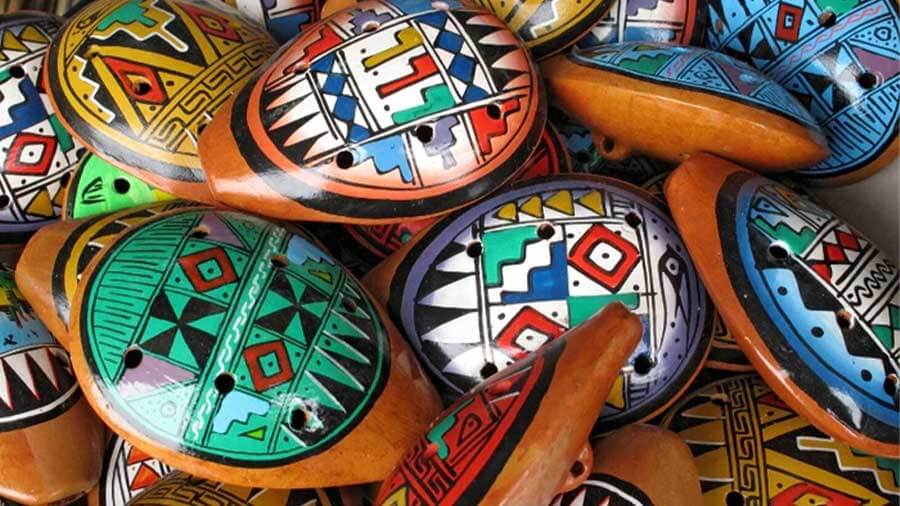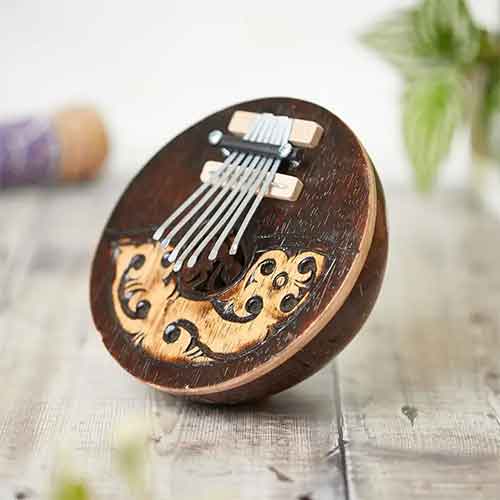An ocarina is a woodwind instrument that origin can be traced back to 5,000 BC throughout America, and India. A clay ocarina is made by firstly making the mouthpiece from clay and using a flat stick to allow air in, it is then added to a bigger piece of clay which will form the rest of the ocarina. The clay mouthpiece is smoothed onto the clay ocarina body facing upwards so that the air hits the roof of it which it then bounces off causing the sound.
A small hole is made in the body and it is carefully hollowed out, after, the hole is sealed back up and the finger holes are made, once it has dried it is painted. There are many variations of ocarinas such as the submarine, animal, pendant, transverse, Inca, and many more and in many shapes and sizes, they are usually made from clay or ceramic, with 4 to 12 finger holes, and a blow-piece. They can also be made from glass, wood, plastic or bone.
Where to buy A Peruvian Ocarina?
An ocarina is a rare musical instrument that is so easy to find, we source ours from Peru and we have many different types available and so we will be discussing that next!
Types of Ocarinas (Buying Guide)
Ocarinas are wind instruments with a history dating back thousands of years, originated in ancient China and Central America, where they were made from clay. When buying a beginner ocarina, consider material, size, tuning, and budget. Ceramic ocarinas are durable and produce warm tones, ideal for beginners.
Smaller ocarinas with fewer holes are easier to play, especially for younger players. Diatonic ocarinas in keys like C or G are recommended for their intuitive learning curve. Accessories like carrying cases, cleaning supplies, and instructional materials can further support beginners.
1. Peruvian Pendant Ocarinas

The Peruvian Ocarina, handmade by skilled artisans in Peru, is a reflection of the country's vibrant culture and craftsmanship. Made from sustainable clay, these eco-friendly instruments come in various shapes and sizes, including popular pendant-style ocarinas that can be worn around the neck.
Suitable for both adults and supervised children over three, each ocarina is intricately hand-painted with designs inspired by the people of Peru, making them ideal for parties or affordable gifts. The classic Ocarina necklace pendant, in particular, is a favorite for its fair trade origins and ability to match different personalities.
Check out our Peruvian Pendant Ocarina here.
2. Alto Dorado Ocarinas

If you're looking for a professional-grade ocarina, the 12-hole Alto Dorado is an excellent choice as it is made from high-quality ceramic. This instrument offers a wide range of notes from A4 to F6. Its ergonomic shape and professional tuning make it comfortable to play for beginners and professionals alike. The Alto Dorado ocarina comes with a case, wrist strap, songbook, and a microfibre cloth, ensuring you have everything you need to start your musical journey. Purchase the Alto Dorado Ocarina here.
3. Nazca Ocarinas

The Nazca ocarina is a stunning Peruvian instrument with a unique design. Hand-painted by skilled artisans in Peru, these ocarinas feature intricate geometric patterns that are a visual delight. This Ocarina is made from sustainable clay, the Nazca ocarinas are not only beautiful but also produce enchanting sounds. With their larger size, they are perfect for both adults and children over three years old. Each Nazca ocarina is one-of-a-kind, as the handmade process creates slight variations in size and shape. Get the Nazca Ocarina here.
4. Inca Ocarinas

For those looking for a complete ocarina set, the boxed Inca ocarinas are an excellent choice. Handmade by skilled artisans in Peru, these ocarinas come in an attractive box, making them perfect as a gift. The boxed Inca ocarinas feature intricate hand-painted designs made from sustainable clay. They are suitable for adults and children over three years old. These ocarinas offer a unique playing experience. Purchase the colourful Inca Ocarina here.
5. Submarine Ocarinas

The Peruvian Submarine Ocarina is a unique musical instrument that combines the shape of a submarine with the musical sound of an ocarina. The submarine ocarina is made from high-quality clay. This instrument is a testament to the creativity and craftsmanship of the Peruvian artisans. The submarine shape adds a distinctive touch to the traditional ocarina design, making it a visually appealing piece. Buy the Peruvian Submarine Ocarina here.
6. Jungle Ocarina

The Jungle Ocarina is a delightful choice for music enthusiasts of all ages, offering a range of fun designs such as ladybirds, turtles, geckos, frogs, and parrots. This handmade ocarina is not only eco-friendly but also easy to play, making it suitable for beginners and advanced players alike. With its assorted animal designs and charming jungle theme, it's the perfect gift for both children and adults. Check out the Jungle Ocarina here.
7. Assorted Animal Ocarinas

The Jungle Ocarina offers a unique and eco-friendly musical experience, handmade with natural clay in assorted animal designs such as turtles, toucans, birds, crocodiles, and ducks. With its 4 holes and mouthpiece area, it allows you to play many songs, making it a versatile woodwind instrument similar to a whistle flute. Handcrafted in Peru, each ocarina is one-of-a-kind in size, color, and design, making it a perfect and distinctive gift. Take home an Assorted Animal Ocarinas here.
8. Llama Ocarina

With a larger variation from the animal ocarinas and has 3 additional holes, our handmade fired clay Llama Ocarina from Peru might be the right match for you!
Choosing the Right Ocarina for You
Now that we have explored the different types of ocarinas available, how do you choose the right one? Here are some factors to consider:
Skill Level
If you're a beginner, it's best to start with a beginner-friendly ocarina that is easy to learn and play. Instruments like the Peruvian ocarinas or the Alto Dorado, with their ergonomic shape and simple finger-hole layout, are perfect for beginners. As you gain experience and proficiency, you can move on to more advanced ocarinas like the Nazca or Inca ocarinas.
Sound Range and Quality
Consider the range and quality of sound that you desire. The Alto Dorado ocarina offers a wide range of notes, making it suitable for playing complex melodies. On the other hand, the Inca and Nazca ocarinas provide a mellower, more traditional sound that is perfect for capturing the essence of ancient cultures.
Design and Aesthetics
Ocarinas are not only musical instruments but also works of art. Consider the design and aesthetics that appeal to you. The Peruvian ocarinas, with their vibrant hand-painted designs, or the Inca ocarinas, with their intricate patterns, are visually stunning choices. Choose an ocarina that resonates with your style and taste.
Portability and Accessories
If you plan on taking your Ocarina with you on the go, consider its portability. Pendant-style ocarinas like the Peruvian ocarinas are compact and can be worn around your neck, making them easy to carry.
Additionally, check if the Ocarina comes with accessories like cases, straps, or cleaning cloths to ensure you have everything you need for a seamless playing experience.
Whether you're a beginner or a professional musician, there is an ocarina out there that is perfect for you. From the Peruvian ocarinas with their vibrant designs to the Inca and Nazca ocarinas that showcase ancient cultures, each type offers a distinct playing experience. Consider your skill level, desired sound range, and personal aesthetics when choosing an ocarina.
What is a transverse ocarina?

Transverse ocarinas are a type of musical instrument that belong to the family of ocarinas. The term "ocarina" refers to any hollow chamber instrument that produces sound. Ocarinas come in various shapes and sizes, ranging from sculptural whistles to concert-quality instruments. Understanding the different types of ocarinas can help you identify the most playable and suitable instrument for your needs.
Sculptural Whistles
Sculptural whistles are novelty items that can mimic the sound of bird calls and other animal sounds. They are often shaped like birds or animals and are highly decorated with colored glaze. While they make great novelty items, sculptural whistles were never intended to be serious musical instruments. They are more of a visual representation of sound rather than instruments designed for serious play.
Pre-Columbian, Peruvian, and Mexican Ocarinas
Various ancient South American cultures, including those in Peru and Mexico, used vessel flutes or ocarinas. These instruments, known as Pre-Columbian ocarinas, were influenced by the natural world and imitated sounds like birds, insects, thunder, wind, and rustling leaves. Today, reproductions of these ocarinas are often sold as tourist souvenirs. However, these reproductions are of poor quality and not tuned properly, making them unsuitable for serious musicians.
Transverse Ocarinas: Italian and Asian
Transverse ocarinas originated in Italy in the 19th century. They are held across the body, similar to a transverse flute, but are shorter and more globular in shape. These ocarinas were designed as serious instruments and feature a linear fingering system similar to that of the recorder or flute. They are fully chromatic and can have anywhere between 9 and 12 holes.
The 10-hole transverse ocarina, created by Guiseppi Donati, was the original design. It plays chromatically over a range of an octave and a fourth. Due to the physics of the instrument, 10-hole ocarinas have a strong, clean sound throughout the range. Some variations of the 10-hole ocarina may have more than 10 physical holes, including split holes for easier playability of sharp or flat notes.
In the 20th century, the 12-hole transverse ocarina was developed in Asia and has become the most commonly available type of transverse ocarina. It uses the same base fingering system as the 10-hole ocarina but adds two additional finger holes that are positioned next to other holes. These holes are played by covering one or both of them with the pad of your finger. The 12-hole ocarina extends the instrument's sounding range downwards by 3 semitones and allows for the playing of accidental notes.
Inline Ocarinas
Inline ocarinas are similar to transverse ocarinas in terms of fingering and hole count but have the mouthpiece placed on the end of the chamber. This design allows the body of the ocarina to be held straight out in front of you, similar to a recorder or whistle. Inline ocarinas may be more suitable for individuals with arthritis, RSI, or other disabilities that may require a different hand position. However, inline ocarinas are less standardized and made by fewer makers.
The inline design of ocarinas poses some unique challenges. They can feel less stable as all the instrument's weight is aligned on a single line between the player's thumbs and lips. Additionally, when scaling up to create bass or contrabass ocarinas, the center of mass moves further forward from the player, making the instrument harder to handle. Acoustically, placing the voicing at the end of the chamber can make inline ocarinas prone to screeching when blown at higher pressures.
Transverse Multichamber Ocarinas
Transverse multichamber ocarinas are single chamber ocarinas with additional small ocarinas attached. These additional chambers are tuned to play as a single instrument and provide a larger range of notes compared to single chamber ocarinas. Multichamber ocarinas can have two (double), three (triple), or even four (quad) chambers. Each chamber is entirely separate, with its own set of finger holes.
Multichamber ocarinas are classified by the number of chambers rather than the hole count. The fingering system of multichamber ocarinas is not fully standardized and varies between makers. Different tunings and fingering systems are used, each with its own pros and cons, and suitability for different types of music. It is important to consult the manufacturer's fingering chart to learn the exact fingerings for a specific multichamber ocarina.
In addition to providing a larger range, multichamber transverse ocarinas have a few other benefits. Splitting the range over multiple chambers can improve tone quality by reducing the range produced by each chamber. Most multichamber ocarinas have only one thumb hole, allowing the right thumb to solely support the instrument. Some multichamber ocarinas, such as those made by Giorgio Pacchioni, can produce harmonies between the chambers, allowing for unique musical possibilities.
Pendant Ocarinas
Pendant ocarinas were developed in the United Kingdom in the 1960s and are compact instruments that can be worn as pendants. They typically have 4 or 5 finger holes and use a binary-like fingering system to play an octave range. Pendant ocarinas can be used for skilled musical performance, but they have some disadvantages compared to transverse ocarinas.
The limited number of holes on pendant ocarinas makes it challenging to achieve accurate tuning compared to transverse ocarinas. The fingering system often requires simultaneous opening and closing of holes, leading to unintended "chirps" if not executed precisely. Some chromatic notes can only be played in tune with balanced volume by partially covering finger holes.
However, pendant ocarinas have unique advantages. They can be smaller in size, allowing for higher pitches and unique musical possibilities. Their compactness and wearable nature make them convenient for spontaneous musical performances. It is important to note that the production quality of pendant ocarinas can vary between makers, and some may not be properly tuned.
Sculptural Ocarinas
Sculptural ocarinas combine playable ocarinas with visual artistry. These ocarinas are typically based on transverse or pendant designs but incorporate sculptural elements. While visually stunning, sculptural ocarinas can be complicated as musical instruments. Achieving both ergonomic playability and good sound quality can be challenging due to the need to balance visual design with acoustic constraints.
Sculptural ocarinas can range from instruments primarily focused on playability to those primarily focused on visual aesthetics. Instruments designed with playability in mind take into account standard playing techniques and the player's comfort in holding the instrument. On the other hand, instruments primarily focused on visuals may sacrifice playability, especially in designs that imitate animals or birds.
The shape of an ocarina can also impact its acoustic characteristics. Irregular shapes can introduce pitch jumps, airy high notes, or screeching sounds. It is important to consider the balance between visual design and musical functionality when choosing a sculptural ocarina.
It is worth noting that there is a market for ocarinas inspired by popular media franchises such as "The Legend of Zelda, Ocarina of Time." However, many of these ocarinas are poorly made and not tuned properly. The designs featured in these games may not prioritize playability, resulting in issues such as non-ergonomic finger hole placements, unstable grip due to the rounded shape, and poor sound quality.
Xuns
The Xun is a Chinese ocarina-like instrument that features a flute-like blowhole instead of a ducted voicing system. Little information is available about Xuns in English, as they are traditional Chinese instruments with their own playing tradition. They may have different fingering systems, including linear systems similar to a 10-hole ocarina or cross fingerings with 6 holes. It is unclear whether Xuns are intended to play within the 12-tone Western system or Chinese microtonal scales.
The flute-like blowhole of Xuns allows for more control and expressive playing, but it also presents challenges in producing sound. Like all vessel flutes, achieving clean high notes requires precise control of the airstream, which takes practice.
Microtonal Ocarinas
Microtonal ocarinas are a specific design of ocarina with one or two large holes covered by the palm of your hand. These ocarinas are played by varying hand position and blowing pressure to produce different pitches. Wesley Hicks has refined the design of microtonal ocarinas in recent years.
Microtonal ocarinas offer a unique playing experience, allowing for the exploration of microtonal scales and intervals that fall outside the standard Western 12-tone system. They require a different approach to playing, as the hand positions and pressures must be carefully adjusted to achieve the desired pitches.
transverse ocarinas are versatile instruments that come in various types, each with its own unique characteristics and playing styles. From sculptural whistles to professional-grade concert instruments, there is an ocarina to suit every player's preferences and skill level. Whether you choose a transverse, pendant, multichamber, or microtonal ocarina, each type offers its own range of musical possibilities. So, explore the world of transverse ocarinas and find the perfect instrument to create beautiful melodies and express your musical creativity.
Ocarinas: Frequently asked questions
What's the history Ocarina?
The ocarina, meaning ‘little goose,’ was named by Italian musician Giuseppe Donati in 1853, who refined its design into the popular sweet potato shape. While its modern form emerged in 19th-century Italy, similar instruments date back to ancient civilizations like the Mayans, Aztecs, and Chinese. Crafted from materials such as clay, bone, and wood, ocarinas have been independently developed in various cultures. Today, they are made globally, with each region contributing unique craftsmanship and artistic touches.
What country is most known for using ocarinas?
Despite the woodwind music instrument being invented in Italy, it is the most known in China as they use it in their role of song and dance. The ocarina has a different name in China and is called Xun. The ocarina has been around for over 12,000 years and is still used today.
How to play Ocarina?
Playing the ocarina is easy to learn, similar to a flute, where you cover the holes to control airflow and produce different sounds by blowing into the mouthpiece. Beginners should start with basic techniques like breath control, finger placement, and scales before progressing to melodies. Simple songs like "Twinkle, Twinkle, Little Star," "Mary Had a Little Lamb," and "Ode to Joy" are great starting points, with online tutorials, books, and videos offering valuable guidance.
what are uses for an ocarina?
Ocarinas serve a multitude of purposes in both traditional and contemporary contexts. In addition to being musical instruments, they hold cultural significance in ceremonies and rituals across different cultures. Ocarinas are used in performances ranging from solo recitals to ensemble playing, and they have found their way into diverse musical genres, including classical, folk, pop, and even video game music.
How to make an Ocarina?
There are many ways of making an ocarina, you can use clay or wood, carve the wood to the shape, make the holes and test to make sure it works, with clay there are plenty of tutorials on how to make one, from beginner-advanced.
Does the ocarina have tuned notes?
Ocarina tuning is done by changing the amount of air used and the speed of air. Lower notes using less slower air and high notes are achieved using more faster air.
What are different types of ocarina?
There are many types, as mentioned in China they have an ocarina instrument that is known as Xun, it has a cone shape. We sell the traditional submarine ocarina that was invented in Italy, the pendant ocarina which is a small hand painted instrument that is great for beginners, animal ocarinas which are more suitable as a kids toy but we also have Inca ocarinas which are much larger and are named after a South American hummingbird.
Are ocarinas easy to learn and how do you practice?
The ocarina is relatively easy to learn for beginners due to its simple design and few finger holes. However, mastering it requires consistent practice. Beginners should start with warm-up exercises, focus on proper breath control and finger placement, and gradually progress to scales and simple melodies. Regular practice, using tutorials or guides, helps develop technical skills and musical expression, making the ocarina a rewarding instrument to play over time.
Utilizing instructional resources such as books and online tutorials can provide valuable guidance. Setting clear goals and practicing regularly are essential for steady progress, with short, focused sessions proving most effective. Seeking feedback from experienced players can offer valuable insights and encouragement. Through consistent practice and dedication, players can improve their skills and achieve their musical goals on the ocarina.
Do you use your tongue while playing the Ocarina?
Yes, the tongue is often used while playing the ocarina to articulate notes and control airflow. Players may use their tongue to start and stop notes, similar to techniques used with wind instruments like the flute or saxophone. Additionally, the tongue can be used to create staccato or legato effects, helping to shape the musical phrases played on the ocarina.
What are staccato or legato effects?
Staccato and legato are two contrasting articulation techniques used in music to shape the way notes are played. Staccato involves playing notes in a short, detached manner, with each note separated from the next to create a crisp and precise sound. This effect is achieved through quick tongue movements or short bursts of breath.
Legato involves playing notes smoothly and connectedly, with each note flowing seamlessly into the next without breaks. This creates a fluid and expressive sound, often achieved by sustaining breath and avoiding abrupt interruptions between notes. Together, staccato and legato techniques add variety and depth to musical performances, allowing musicians to convey different emotions and nuances in their playing.
How to maintain my Ocarina?
Maintaining your ocarina is essential for preserving its condition and ensuring optimal performance. Regular cleaning with a soft, dry cloth removes moisture and oils, while occasional deep cleaning with a damp cotton swab prevents buildup in finger holes and mouthpieces. Store your ocarina in a protective case or pouch to shield it from dust, dirt, and damage, avoiding exposure to extreme temperatures or humidity. Handle your ocarina with care to prevent dropping or impact damage, especially during transportation.
Consider oiling clay or ceramic ocarinas to maintain their finish and prevent drying or cracking. Regularly inspect your ocarina for signs of damage and have it repaired promptly if necessary. By following these maintenance practices, you can prolong the lifespan of your ocarina and enjoy its music for years to come.









